He didn’t want to get married, but he had to. The nobles of Cracow ordered him to wed and quickly. Leszek the White gave in to the pressure and married a young Ruthenian princess. Thus was born an alliance meant to end wars, stabilize borders, and give Poland a new heir. But did everything go according to plan?
The Prince with White Hair
Leszek the White is one of the more recognizable princes of Cracow from the period of regional disintegration. His rule certainly wasn’t among the most outstanding. That doesn’t mean, however, that he ruled ineffectively or lacked all talent, as some historians have tried to claim. The exact date of Leszek’s birth is unknown. Genealogists estimate he was born between 1184 and 1187. His father was Casimir II the Just, Duke of Cracow; his mother, Helena of Znojmo, a Moravian princess. When his father died in 1194, Leszek was no more than ten years old – too young to rule on his own. Power was exercised on his behalf by regents: the Cracow voivode Mikołaj, Bishop Pełka, and the dowager duchess.
This arrangement was unacceptable to Mieszko III the Old, Duke of Greater Poland and then senior of the Piast dynasty, who had previously been deposed from the Cracow throne. Mieszko chose to reclaim his rights by force. In 1195, he clashed with the Lesser Polish forces near Jędrzejów at the Mozgawa River. The battle was bloody. Mieszko himself was seriously wounded. In the end, his troops retreated, allowing Leszek’s camp to maintain its hold on power.
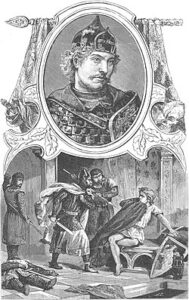
Around 1200, when Leszek the White and his slightly younger brother Conrad of Masovia reached adulthood, they divided their father’s inheritance. Conrad settled in Masovia and Kuyavia, while Leszek ruled the land of Sandomierz. After Mieszko the Old died in 1202, envoys from Lesser Poland came to Leszek in Sandomierz and offered him the Cracow throne on the condition that he dismiss Sandomierz voivode Goworek. Leszek refused, prompting Cracow’s voivode Mikołaj to invite Mieszko’s son, Władysław Spindleshanks, to take the Cracow throne.
It’s hard to say how long Władysław ruled Cracow. Historians are divided. One view suggests he ruled until 1206. Until then, Lesser Poland had two competing power centers: Cracow and Sandomierz. In truth, neither Leszek nor Władysław was strong enough to eliminate the other.
Leszek the White’s Ruthenian Policy
As a young man, Leszek led an expedition to Ruthenia, installing Prince Roman on the throne of Halych-Volhynia. That Polish-Ruthenian alliance lasted only a few years. In 1205, for reasons that remain unclear, Roman invaded Polish lands, suffering a devastating defeat at the hands of the Piast princes at the Battle of Zawichost. Roman was killed, and this opened the way for Polish expansion eastward.
Leszek the White was especially determined to extend Polish influence in Ruthenia. But he immediately encountered similar ambitions from Andrew II, King of Hungary. In 1206, the two monarchs reached an agreement dividing spheres of influence: the Piasts would control Volhynia, and the Árpáds would dominate Halych.
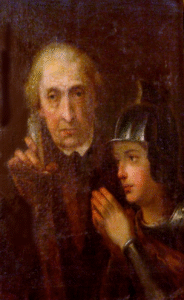
That Polish-Hungarian pact would be revised several times, sometimes in favor of Poland, other times Hungary. Leszek was repeatedly forced to intervene militarily and forge alliances with various Ruthenian princes.
Beautiful Grzymisława
Leszek’s eastern policy was closely tied to his marriage to Grzymisława. She was likely the daughter of Prince Ingvar Yaroslavich of Lutsk, a figure about whom little is known. Genealogists suggest Ingvar was born around 1166 and lived just under fifty years. He ruled first in Dorohobuzh, later taking over Lutsk. In 1212, he briefly seized Kyiv but was forced out. He died two years later.
Grzymisława was born no later than 1195. We know nothing about her early years. It is assumed she spent her childhood in Lutsk, but no source confirms this. Her mother’s name and origin are unknown.
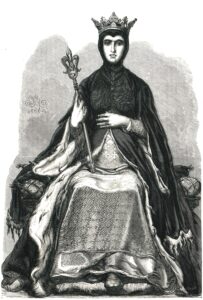
A turning point came around 1207 when Grzymisława married Leszek the White. Jan Długosz left a detailed description of their wedding in his chronicle. According to him, „the nobles of Cracow, fearing that if their prince died childless they would fall under foreign rule, pressured twenty-eight-year-old Leszek to take a wife. Advisors offered various candidates: some preferred Hungary, others Germany, Bohemia, or Ruthenia. The faction favoring Ruthenia prevailed. They believed an alliance with the Ruthenians would allow Poland to expand and help restore peace after many wars and conflicts. Thus, following their counsel, Leszek married Grzymisława, daughter of Prince Yaroslav of Ruthenia, a young woman distinguished by her noble lineage, character, and beauty. The wedding in Cracow was lavish, with knightly tournaments and festivities lasting several days. Thanks to the marriage, a lasting and blessed peace dawned between Poles and Ruthenians. Old grievances were forgotten, prisoners of war were released, both nobles and commoners alike”.
Historians have long criticized Długosz’s account as largely fictional. His date for the wedding (1120) is clearly wrong; it happened earlier, as confirmed by Ruthenian sources. Leszek was just over twenty, not nearly thirty. Długosz also misidentified Grzymisława’s father as Prince Yaroslav, though she was closely related to him, likely his granddaughter.
See also: Masovia in the Hands of a Woman. The Story of a Forgotten Princess
The wedding did indeed take place in Cracow, then the key stronghold of the seniorate, ruled by Leszek. It’s also plausible that the festivities lasted many days, a common practice for dynastic weddings. However, the idea that the couple enjoyed knightly tournaments is questionable. Such events only spread to Poland via Bohemia in the mid-13th century. One historian noted that Leszek, following his father’s policy, aimed to maintain cordial relations with the Church, which strongly opposed these violent tournaments. Organizing such an event on his wedding day would have risked offending the clergy.
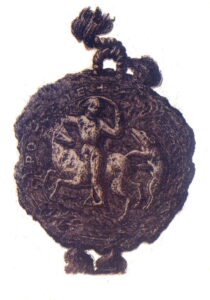
The Marriage of Leszek and Grzymisława
Initially, Grzymisława focused on the everyday affairs of the ducal court. After giving birth to her first child, she naturally devoted herself to motherhood. Around 1212, she bore a daughter, Salomea, the future Blessed. According to Długosz, Leszek was disappointed—he had hoped for a son. But he came to accept his daughter and, when she was three, arranged her betrothal to seven-year-old Coloman, son of King Andrew II.
Salomea left Cracow in 1218 to join her husband in Halych. At age ten, in 1221, she and Coloman were captured by Prince Mstislav the Bold of Novgorod. During her captivity (probably then), she made a vow of chastity, later approved by Coloman. After their release, they moved to Croatia, which Coloman began to govern in 1226. Historians note that the Polish-Hungarian marriage alliance helped neutralize the Hungarian threat to Piast ambitions in Ruthenia.
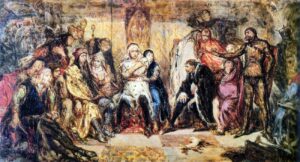
On June 21, 1226, in Stary Korczyn, Grzymisława gave birth to a long-awaited son, Bolesław the Chaste. He was named after his warlike grandfather, Bolesław the Wrymouth, indicating the parents’ high hopes. A grand feast was held in Crakow to celebrate. Overjoyed, Leszek distributed land grants to many individuals and institutions.
See also: The Tragic Death of Leszek the White, Husband of Grzymisława
The birth of a male heir elevated Grzymisława’s status dramatically. Until then, she had played no prominent role, merely watching her husband struggle to maintain the seniorate and balance noble and ecclesiastical pressures. Now, as mother of the heir to the throne, the chroniclers could no longer ignore her.
Bibliography:
-Balzer O., Walka o tron krakowski w latach 1202–1210/11, „Rozprawy Akademii Umiejętności, Wydział Filozoficzno-Historyczny” 1894, t. 30.
-Chrzanowski M., Leszek Biały, książę krakowski i sandomierski, princeps Poloniae (ok. 1184 – 23/24 listopada 1227), Kraków 2013.
-Dąbrowski D., Dwa ruskie małżeństwa Leszka Białego. Karta z dziejów Rusi halicko-włodzimierskiej i stosunków polsko-ruskich w początkach XIII w., „Roczniki Historyczne” 2006, t. 72.
-Dąbrowski D., Genealogia Mścisławowiczów, Kraków 2008.
-Faron B., Święte i tygrysice. Piastówny i żony Piastów 1138–1320, Kraków 2018.
-Jasiński K., Rodowód Piastów małopolskich i kujawskich, Poznań–Wrocław 2001.
-Michalski M., Kobiety i świętość w żywotach trzynastowiecznych księżnych polskich, Poznań 2004.
-Rosik S., Wiszewski P., Wielki poczet polskich królów i książąt, Wrocław 2007.
-Samsonowicz H., Leszek Biały, [w:] Poczet królów i książąt polskich, red. A. Garlicki, Warszawa 1980.
-Sobociński W., Historia rządów opiekuńczych w Polsce, „Czasopismo Prawno-Historyczne” 1949, t. 2.
-Spórna M., Grzymisława, [w:] Słownik władców Polski i pretendentów do tronu polskiego, Kraków 2003.
-Teterycz-Puzio A., Zamachy na Piastów, Poznań 2019.
-Włodarski B., Polska i Ruś 1194–1340, Warszawa 1966.
-Zabłocki W., Grzymisława Ingwarówna, księżna krakowsko-sandomierska, Kraków 2012.
Author: Mariusz Samp